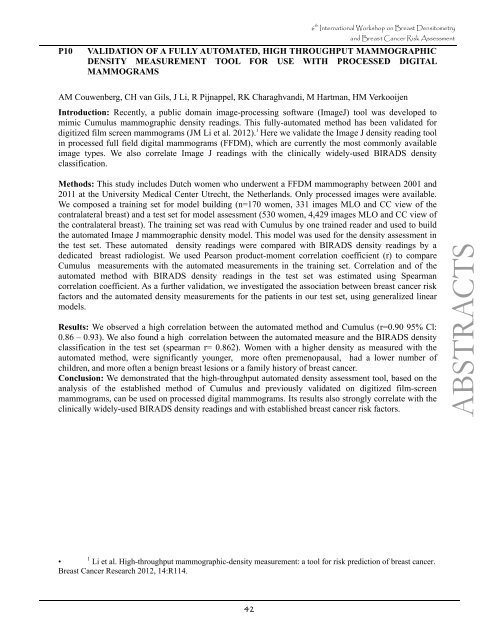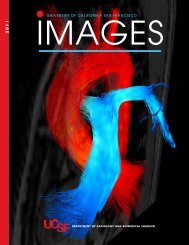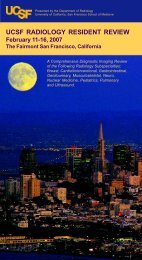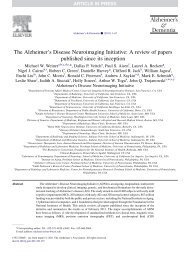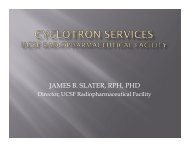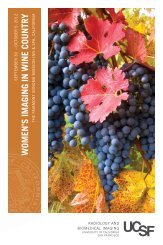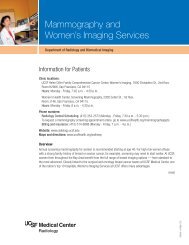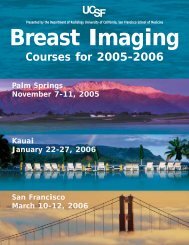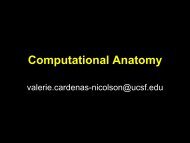6th International Workshop on Breast Densitometry and Breast ...
6th International Workshop on Breast Densitometry and Breast ...
6th International Workshop on Breast Densitometry and Breast ...
- No tags were found...
Create successful ePaper yourself
Turn your PDF publications into a flip-book with our unique Google optimized e-Paper software.
P10<br />
6 th <str<strong>on</strong>g>Internati<strong>on</strong>al</str<strong>on</strong>g> <str<strong>on</strong>g>Workshop</str<strong>on</strong>g> <strong>on</strong> <strong>Breast</strong> <strong>Densitometry</strong><br />
<strong>and</strong> <strong>Breast</strong> Cancer Risk Assessment<br />
VALIDATION OF A FULLY AUTOMATED, HIGH THROUGHPUT MAMMOGRAPHIC<br />
DENSITY MEASUREMENT TOOL FOR USE WITH PROCESSED DIGITAL<br />
MAMMOGRAMS<br />
AM Couwenberg, CH van Gils, J Li, R Pijnappel, RK Charaghv<strong>and</strong>i, M Hartman, HM Verkooijen<br />
Introducti<strong>on</strong>: Recently, a public domain image-processing software (ImageJ) tool was developed to<br />
mimic Cumulus mammographic density readings. This fully-automated method has been validated for<br />
digitized film screen mammograms (JM Li et al. 2012). i Here we validate the Image J density reading tool<br />
in processed full field digital mammograms (FFDM), which are currently the most comm<strong>on</strong>ly available<br />
image types. We also correlate Image J readings with the clinically widely-used BIRADS density<br />
classificati<strong>on</strong>.<br />
Methods: This study includes Dutch women who underwent a FFDM mammography between 2001 <strong>and</strong><br />
2011 at the University Medical Center Utrecht, the Netherl<strong>and</strong>s. Only processed images were available.<br />
We composed a training set for model building (n=170 women, 331 images MLO <strong>and</strong> CC view of the<br />
c<strong>on</strong>tralateral breast) <strong>and</strong> a test set for model assessment (530 women, 4,429 images MLO <strong>and</strong> CC view of<br />
the c<strong>on</strong>tralateral breast). The training set was read with Cumulus by <strong>on</strong>e trained reader <strong>and</strong> used to build<br />
the automated Image J mammographic density model. This model was used for the density assessment in<br />
the test set. These automated density readings were compared with BIRADS density readings by a<br />
dedicated breast radiologist. We used Pears<strong>on</strong> product-moment correlati<strong>on</strong> coefficient (r) to compare<br />
Cumulus measurements with the automated measurements in the training set. Correlati<strong>on</strong> <strong>and</strong> of the<br />
automated method with BIRADS density readings in the test set was estimated using Spearman<br />
correlati<strong>on</strong> coefficient. As a further validati<strong>on</strong>, we investigated the associati<strong>on</strong> between breast cancer risk<br />
factors <strong>and</strong> the automated density measurements for the patients in our test set, using generalized linear<br />
models.<br />
Results: We observed a high correlati<strong>on</strong> between the automated method <strong>and</strong> Cumulus (r=0.90 95% Cl:<br />
0.86 – 0.93). We also found a high correlati<strong>on</strong> between the automated measure <strong>and</strong> the BIRADS density<br />
classificati<strong>on</strong> in the test set (spearman r= 0.862). Women with a higher density as measured with the<br />
automated method, were significantly younger, more often premenopausal, had a lower number of<br />
children, <strong>and</strong> more often a benign breast lesi<strong>on</strong>s or a family history of breast cancer.<br />
C<strong>on</strong>clusi<strong>on</strong>: We dem<strong>on</strong>strated that the high-throughput automated density assessment tool, based <strong>on</strong> the<br />
analysis of the established method of Cumulus <strong>and</strong> previously validated <strong>on</strong> digitized film-screen<br />
mammograms, can be used <strong>on</strong> processed digital mammograms. Its results also str<strong>on</strong>gly correlate with the<br />
clinically widely-used BIRADS density readings <strong>and</strong> with established breast cancer risk factors.<br />
ABSTRACTS<br />
•<br />
1 Li et al. High-throughput mammographic-density measurement: a tool for risk predicti<strong>on</strong> of breast cancer.<br />
<strong>Breast</strong> Cancer Research 2012, 14:R114.<br />
42


